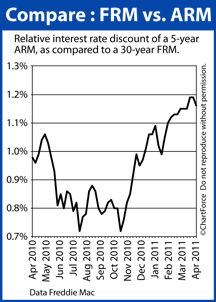
Which is better — a fixed-rate mortgage or an adjustable-rate mortgage? It’s a common question among home buyers and refinancing households in Minnesota.
The answer? It depends.
Fixed-rate mortgages give the certainty of a known, unchanging principal + interest payment for the life of the loan. This can help you with budget-setting and financial planning. Some homeowners say fixed-rate loans they offer “peace of mind”.
Adjustable-rate mortgages do not.
After a pre-determined, introductory number of years, the initial interest rate on the note moves up or down, depending on the existing market conditions. It then adjust again every 12 months thereafter until the loan is paid in full.
ARMs can adjust higher or lower so they are necessarily unpredictable long-term. However, if you can be comfortable with uncertainty like that, you’re often rewarded with a very low initial interest rate — much lower than a comparable fixed rate loan, anyway.
Freddie Mac’s weekly mortgage survey highlights this point.
The interest rate gap between fixed-rate mortgages and adjustable-rate mortgages is growing. It peaked 2 weeks ago, but remains huge at 1.16 percentage points.
On a $200,000 home loan, this FRM/ARM spread yields a monthly principal + interest payment difference of $136, or $8,160 over 5 years, the typical initial rate period.
Savings like that can be compelling and may push you toward an adjustable rate loan.
You might also consider a 5-year ARM over a fixed-rate loan if any of these scenarios apply:
- The home you need costs more than you qualify for on a fixed rate
- Your projected earnings will out pace the projected increase in payment.
- The home you qualify for meets your needs now, but you know you will outgrow the home and the arm allows you to buy the home you plan to grow into. The net result is you save substantial money because of selling, moving and closing costs.
- You’re buying a new home with the intent to sell it within 5 years
- You’re currently financed with a 30-year fixed mortgage and have plans to sell the home within 5 years
- You’re interested in low payments, and are comfortable with longer-term payment uncertainty
Furthermore, homeowners whose existing ARMs are due for adjustment might want to refinance into a brand new ARM, if only to push the rate period farther into the future.
Before choosing ARM over fixed, though, make sure you speak with your loan officer about how adjustable rate mortgages work, and their near- and long-term risks. The payment savings may be tempting, but with an ARM, the payments are never permanent.

Leave a Reply